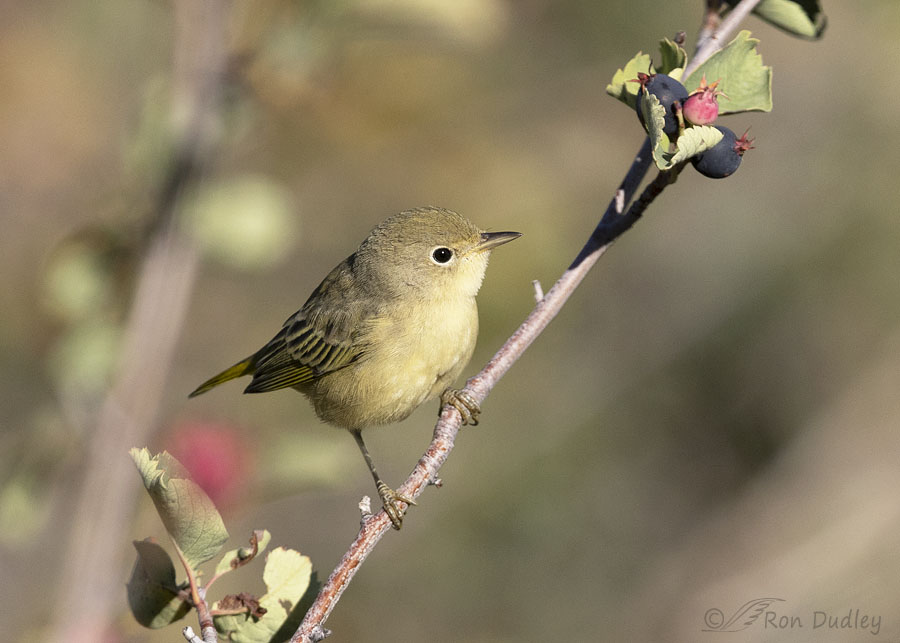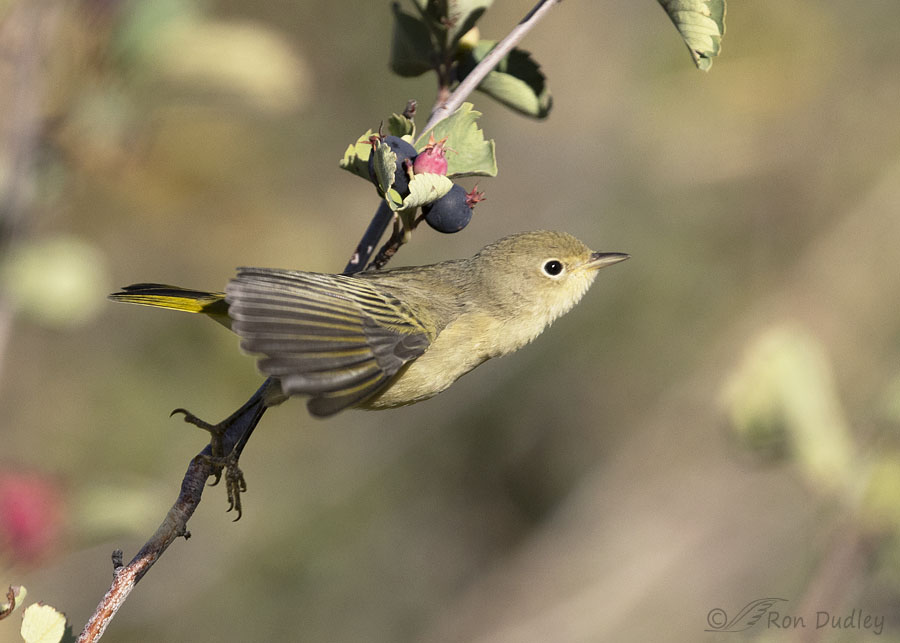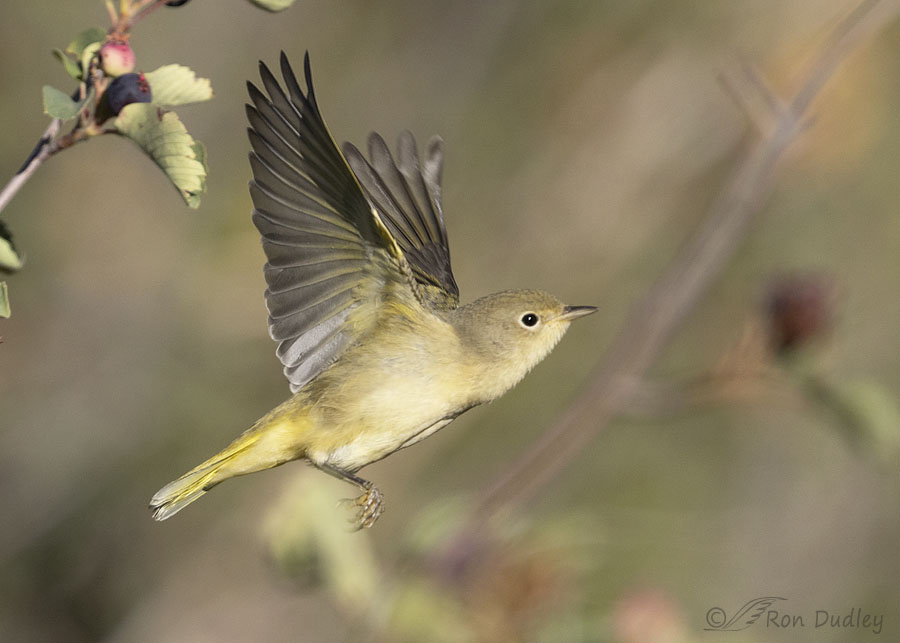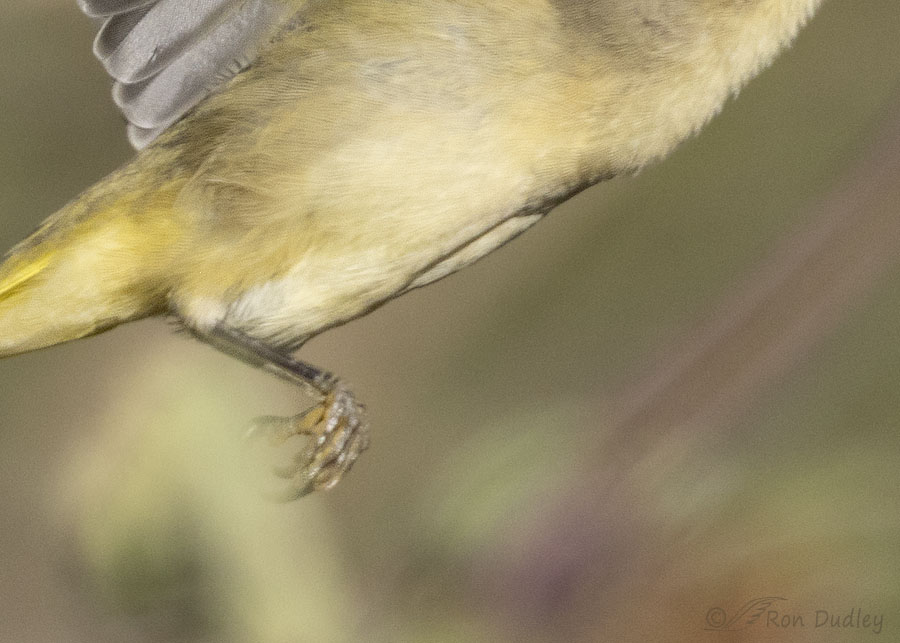One way to tell the difference between an adult female and a juvenile Yellow Warbler?
Yesterday morning I found a mixed flock of songbirds feeding on serviceberries, gleaning insects off of the foliage and hawking insects out of the air. The flock included Yellow Warblers, Orange-crowned Warblers, Cedar Waxwings and Western Tanagers and even though most of them weren’t particularly close, the shooting was often fast and furious.

1/5000, f/7.1, ISO 800, Canon R5, Canon EF500mm f/4L IS II USM + 1.4 tc, not baited, set up or called in
Unlike most warblers, this adult female Yellow Warbler actually stayed on this branch long enough that I had time to get quite a few shots of her. Most of the time her tail was blocked by the out of focus branch on the left but when she twisted slightly to her right I got this shot that included her entire body.
Because they’re so incredibly quck and twitchy, attempting to get sharp takeoff and flight shots of most warblers is usually a waste of time but I often try anyway. I fired off several short bursts hoping to get lucky but she just stood there watching me.

1/5000, f/7.1, ISO 800, Canon R5, Canon EF500mm f/4L IS II USM + 1.4 tc, not baited, set up or called in
But the last burst worked. I caught her taking off and…

1/5000, f/7.1, ISO 800, Canon R5, Canon EF500mm f/4L IS II USM + 1.4 tc, not baited, set up or called in
in flight. This shot isn’t quite tack sharp but I think it’s ‘sharp enough’, whatever that is.
At first I couldn’t tell for sure if this bird was an adult female or a juvenile but I think we get a clue in this photo that strongly suggests that she’s an adult female. Can you spot the clue?

I believe the depression we see in her plumage on her upper belly indicates the presence of a brood patch. In Yellow Warblers only females incubate eggs and juveniles wouldn’t have a brood patch so this bird is an adult female.
If my logic is flawed I’d like to hear about it.
Ron


Lovely, muted yellows. So glad she stuck around — for you and for us.
So glad she stuck around — for you and for us.
Thanks, Marty.
Very late to the party this morning. I slept in until after dawn which is almost unheard of for me.
Love this series and was very interested in your supposition and Dan’s affirmation and addition info.
Thank you.
I hope it was a good “slept in”, EC. And you can be late to any party of mine.
Late today Ron, but enjoying the post regardless. Quite an array of birds to be trying to gets of all. Knew she was an adult female, but probably could not have said why until reading you explanation, Thanks for that. Good takeoff – and not easy with small birds.
Thank you, Everett.
What a cooperative little bird! All of these photos are much better than what’s in “The Warbler Guide” for the females. Congrats!
What a fun morning it must have been – we had a big flock of cedar waxwings last summer, and watching them hawking was fascinating.
(The avian potpourri yesterday was great, too!)
Thanks, Carolyn. The entire morning didn’t go like that but for almost half an hour I was really giving my camera a workout.
Sharp enough for me! Interesting about the brood patch – know they have them but never would have occurred to me to look for it as an identifier! They are “twitchy” for sure….. Appears it’s getting pretty dry where the serviceberry bush is. We’re into the heat thing for the next few days – UGH!
Appears it’s getting pretty dry where the serviceberry bush is. We’re into the heat thing for the next few days – UGH!
Judy, actually there’s been some pretty good rains up there this summer and we had a very wet winter and spring so berries of all kinds seem to be thriving right now. Lots of fruits but usually not enough birds to even put a dent in them.
Great series. Getting a good shot of any warbler in flight is hard enough but timing it to get the take off is something I’ve seldom seen photos of. The brood patch trick works well for now but it will be gone after molt. There are many species where males also develop a brood patch but for this species it is a good indication of adult female vrs. juvenile in late summer. It’s likely that the spongy condition of the skin, characteristic of a brood path, has already regressed to near normal but the depression in the plumage may remain until new feathers grow in at molt.
Thanks, Dan. I was hoping you’d weigh in on this.
Sensational series!
Charlotte Norton
Thanks, Charlotte.
Very impressive. Those little guys are FAST! “Sharp enough” indeed. I would have never thought to look for a brood patch. Did not know that was a thing. Clearly there is a depression there.
That 3rd photo is a beauty.
Thanks, Michael. I like that flight shot a lot too, partly because of the “degree of difficulty” thing.
What a lovely bird, especially in shot #1…..that serviceberry patch
sounds like a photographer’s dream ! I’m looking forward to future
posts from your bonanza yesterday, and I liked learning about the
“brood patch” as a signal of gender in this species……
“that serviceberry patch sounds like a photographer’s dream”
It is, Kris. At least it was yesterday morning. I’ll definitely be checking it out again. And soon.